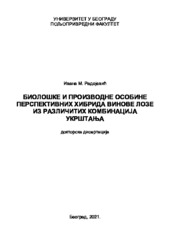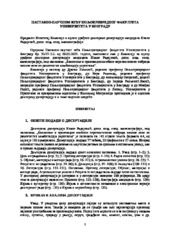Приказ основних података о дисертацији
Биолошке и производне особине перспективних хибрида винове лозе из различитих комбинација укрштања
Biological and production traits of promising grapevine hybrids from different crossing combinations
| dc.contributor.advisor | Nikolić, Dragan | |
| dc.contributor.other | Rakonjac, Vera | |
| dc.contributor.other | Petrović, Aleksandar | |
| dc.contributor.other | Ranković-Vasić, Zorica | |
| dc.contributor.other | Garić, Mlađan S. | |
| dc.creator | Radojević, Ivana | |
| dc.date.accessioned | 2021-12-10T14:13:08Z | |
| dc.date.available | 2021-12-10T14:13:08Z | |
| dc.date.issued | 2021-09-24 | |
| dc.identifier.uri | http://eteze.bg.ac.rs/application/showtheses?thesesId=8385 | |
| dc.identifier.uri | https://fedorabg.bg.ac.rs/fedora/get/o:24556/bdef:Content/download | |
| dc.identifier.uri | http://vbs.rs/scripts/cobiss?command=DISPLAY&base=70036&RID=52638985 | |
| dc.identifier.uri | https://nardus.mpn.gov.rs/handle/123456789/18728 | |
| dc.description.abstract | Код три перспективна хибрида винове лозе створених у Центру за виноградарство и винарство у Нишу (НИ 11-92, НИ 8-92 и НИ 2-92), намењених за производњу вина, проучаване су њихове најважније биолошке и производне особине. Истраживања су обављена у колекционом винограду у периоду од 2011. до 2013. године у агроеколошким условима Ниша, тј. Кутинског виногорја. Коришћењем стандардне методологије код испитиваних хибрида проучаване су фенолошке фазе, морфолошке особине појединих органа, родни потенцијал, принос грожђа, механичкии састав грозда и бобице, квалитет грожђа, хемијски састав вина и сензорна оцена вина. Циљ рада био је да се за проучаване особине испитивани хибриди упореде најпре са својим родитељима (Прокупац, Гаме црни, Смедеревка, Траминац црвени и Ризлинг рајнски), а потом и међусобно како би се на основу добијених резултата могли препоручити Комисији за признавање нових сорти винове лозе или њихово даље укључивање у оплемењивачке програме. У раду је утврђено да су хибриди НИ 11-92 и НИ 2-92 имали раније просечно кретање окаца и почетак цветања од својих родитеља, док су се време кретања окаца и почетак цветања хибрида НИ 8-92 кретали између родитељских сорти. Код хибрида НИ 11-92 установљено је такође раније време зрења од родитеља, код хибрида НИ 8-92 оно је било у нивоу ранијег и раније од познијег родитеља, а код хибрида НИ 2-92 оно је било између родитеља. Од морфолошких особина највећу сличност са својим родитељима показао је хибрид НИ 11-92, а највећу различитост хибрид НИ 8-92. Коефицијенти потенцијалне, релативне и апсолутне родности као показатељи родног потенцијала испољили су највеће вредности код сва три испитивана хибрида и у највећем броју случајева значајно су се разликовали од једног, а ређе од оба родитеља. Испитивани хибриди и њихови родитељи значајно су се разликовали у приносу грожђа по чокоту. У односу на родитеље виши принос грожђа по чокоту утврђен је код хибрида НИ 8-92, док је код хибрида НИ 11-92 и НИ 2-92 он био између родитељских сорти. Значајне разлике између хибрида НИ 8-92, као и хибрида НИ 2-92 и њихових родитеља установљене су за све особине грозда (број гроздова по чокоту, маса грозда, дужина грозда, ширина грозда, број бобица у грозду и маса огроздине), док између хибрида НИ 11-92 и његових родитеља разлике нису биле значајне једино за ширину грозда. Хибрид НИ 11-92 и његови родитељи значајно су се разликовали по маси 100 бобица, маси покожице у 100 бобица и маси мезокарпа у 100 бобица, хибрид НИ 8-92 и његови родитељи по маси 100 бобица и маси мезокарпа у 100 бобица, а хибрид НИ 2-92 и његови родитељи по маси 100 бобица, маси мезокарпа у 100 бобица и маси семенки у 100 бобица. У односу на родитеље хибрид НИ 11-92 је имао веће учешће бобица у грозду и мезокарпа у бобици, хибрид НИ 8-92 је имао мање учешће бобица у грозду, а веће учешће мезокарпа у бобици, док је хибрид НИ 2-92 имао мање учешће бобица у грозду и мезокарпа у бобици. Учешће покожице у бобици код хибрида НИ 11-92 и НИ 8-92 било је мање, а код хибрида НИ 2-92 је било веће у односу на њихове родитеље. Садржај шећера у шири хибрида НИ 11-92 је у просеку био значајно већи него код сорти родитеља, док је садржај укупних киселина у шири био већи, али се није значајно разликовао од родитеља. За садржај шећера и укупних киселина у шири утврђена је значајна разлика између хибрида НИ 8-92, као и хибрида НИ 2-92 и њихових родитеља. Параметри хемијског састава вина испитиваних хибрида и родитељских партнера варирали су у зависности од карактеристика производне године. Сензорна оцена вина свих испитиваних хибрида за све три производне године била је између оцене њихових родитеља, изузев за хибрид НИ 11-92 у 2012. години... | sr |
| dc.description.abstract | The three promising grapevine hybrids created at the Center for Viticulture and Enology in Niš (NI 11-92, NI 8-92 and NI 2-92), intended for wine production, were used to study their most important biological and production characteristics. The research was performed in the collection vineyard in the period from 2011 to 2013 in the agroecological conditions of Niš, ie. Kutina winegrowing subregion. Using the standard methodology in the examined hybrids, the phenological phases, morphological characteristics of individual organs, generative potential, grape yield, mechanical composition of bunch and berry, grape quality, chemical composition of wine and sensory evaluation of wine were studied. The aim of this study was to compare the examined hybrids first with their parents (Prokupac, Gamay Noir, Smederevka, Gewürztraminer and Rhine Riesling), and then with each other so that based on the obtained results they could be recommended to the Commission for recognition of new grapevine varieties or their further inclusion in breeding programs. It was determined that the hybrids NI 11-92 and NI 2-92 had earlier average bud burst and the beginning of flowering from their parents, while the time of bud burst and the beginning of flowering of NI 8-92 hybrid were between the parental varieties. In the NI 11-92 hybrid, the earlier ripening time from the parents was also established, in the NI 8-92 hybrid it was at the level of the earlier and earlier than the later parent, and in the NI 2-92 hybrid it was between the parents. Of the morphological traits, the NI 11-92 hybrid showed the greatest similarity with its parents, and the NI 8-92 hybrid showed the greatest difference. The coefficients of potential, relative and absolute fruitfulness as indicators of yield potential showed the highest values in all three examined hybrids and in most cases differed significantly from one, and less often from both parents. The examined hybrids and their parents differed significantly in grape yield per vine. Compared to the parents, a higher yield of grapes per vine was found in hybrids NI 8-92, while in hybrids NI 11-92 and NI 2-92 it was between the parental varieties. Significant differences between NI 8-92 hybrid, as well as NI 2-92 hybrid and their parents were found for all bunch characteristics (number of bunches per vine, bunch weight, bunch length, bunch width, number of berries in the bunch and bunch stem weight), while between the NI 11-92 hybrid and its parents the differences were not significant only for bunch width. Hybrid NI 11-92 and his parents differed significantly in weight of 100 berries, skin weight in 100 berries and weight of mesocarp in 100 berries, hybrid NI 8-92 and his parents in weight of 100 berries and weight of mesocarp in 100 berries, and hybrid NI 2-92 and his parents by weight of 100 berries, weight of mesocarp in 100 berries and weight of seeds in 100 berries. Compared to the parents, the hybrid NI 11-92 had a higher share of berries in the bunch and mesocarp in the berry, the hybrid NI 8-92 had a lower share of berries in the bunch, and a higher share of mesocarp in the berry, while the hybrid NI 2-92 had less share of berries in the bunch and mesocarp in the berry. The share of skin in the berry in hybrids NI 11-92 and NI 8-92 was lower, and in hybrid NI 2-92 it was higher compared to their parents. The sugar content in the must of hybrid NI 11-92 was on average significantly higher than in the parental varieties, while the content of total acids in the must was higher, but did not differ significantly from the parents. For the content of sugars and total acids in the must, a significant difference was found between hybrid NI 8-92, as well as hybrid NI 2-92 and their parents. The parameters of the chemical composition of the wine of the examined hybrids and parental partners varied depending on the characteristics of the production year. The sensory evaluation of wine of all examined hybrids for all three production years was between the evaluation of their parents, except for the hybrid NI 11-92 in 2012... | en |
| dc.format | application/pdf | |
| dc.language | sr | |
| dc.publisher | Универзитет у Београду, Пољопривредни факултет | sr |
| dc.rights | openAccess | en |
| dc.rights.uri | https://creativecommons.org/licenses/by-nc-nd/4.0/ | |
| dc.source | Универзитет у Београду | sr |
| dc.subject | винова лоза | sr |
| dc.subject | grapevine | en |
| dc.subject | хибридизација | sr |
| dc.subject | селекција | sr |
| dc.subject | морфолошке особине | sr |
| dc.subject | фенологија | sr |
| dc.subject | родни потенцијал | sr |
| dc.subject | принос | sr |
| dc.subject | квалитет грожђа | sr |
| dc.subject | квалитет вина | sr |
| dc.subject | hybridization | en |
| dc.subject | selection | en |
| dc.subject | morphological traits | en |
| dc.subject | phenology | en |
| dc.subject | generative potential | en |
| dc.subject | yield | en |
| dc.subject | grape quality | en |
| dc.subject | wine quality | en |
| dc.title | Биолошке и производне особине перспективних хибрида винове лозе из различитих комбинација укрштања | sr |
| dc.title.alternative | Biological and production traits of promising grapevine hybrids from different crossing combinations | en |
| dc.type | doctoralThesis | |
| dc.rights.license | BY-NC-ND | |
| dcterms.abstract | Николић, Драган; Ранковић-Васић, Зорица; Ракоњац, Вера; Гарић, Млађан С.; Петровић, Aлександар; Радојевић, Ивана; Biološke i proizvodne osobine perspektivnih hibrida vinove loze iz različitih kombinacija ukrštanja; | |
| dc.identifier.fulltext | http://nardus.mpn.gov.rs/bitstream/id/77550/Disertacija_11717.pdf | |
| dc.identifier.fulltext | http://nardus.mpn.gov.rs/bitstream/id/77551/Izvestaj_Komisije_11717.pdf | |
| dc.identifier.rcub | https://hdl.handle.net/21.15107/rcub_nardus_18728 |



